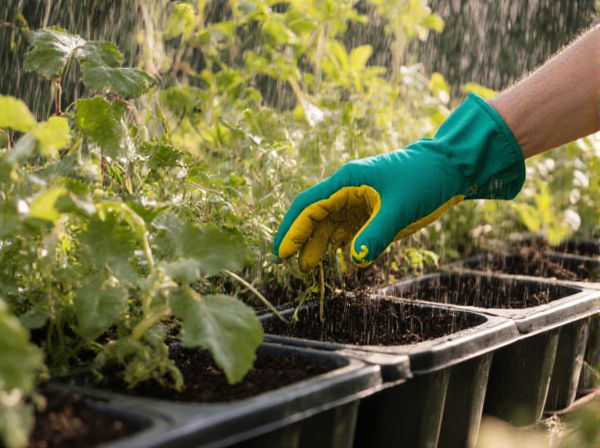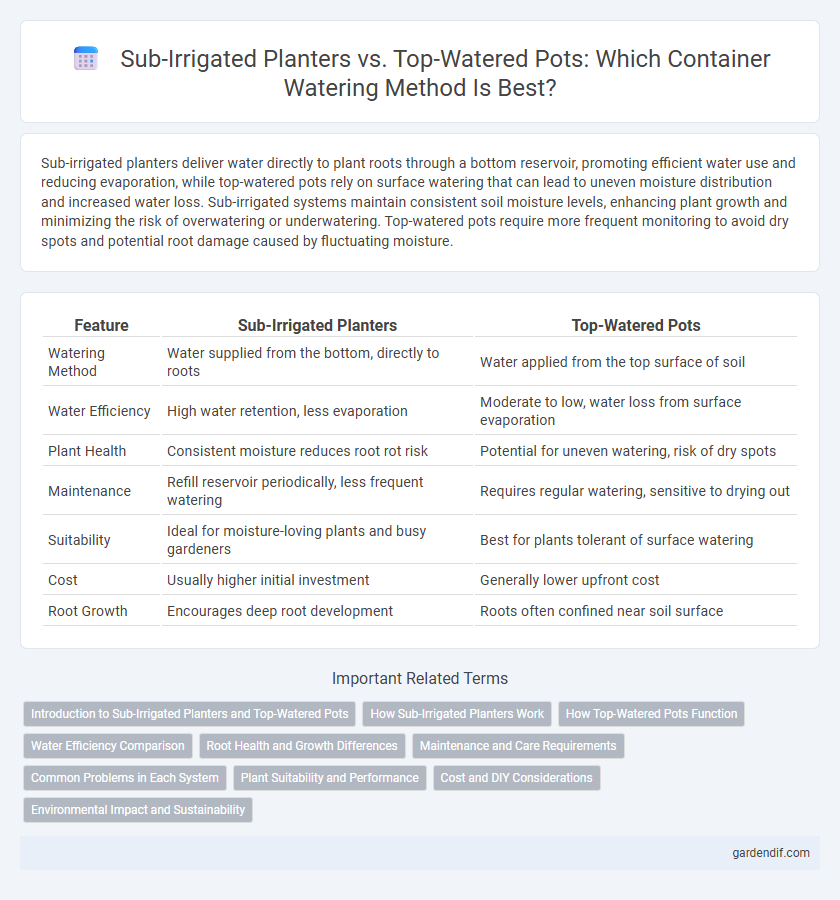
Sub-irrigated planters vs top-watered pots Illustration
Sub-irrigated planters deliver water directly to plant roots through a bottom reservoir, promoting efficient water use and reducing evaporation, while top-watered pots rely on surface watering that can lead to uneven moisture distribution and increased water loss. Sub-irrigated systems maintain consistent soil moisture levels, enhancing plant growth and minimizing the risk of overwatering or underwatering. Top-watered pots require more frequent monitoring to avoid dry spots and potential root damage caused by fluctuating moisture.
Table of Comparison
| Feature | Sub-Irrigated Planters | Top-Watered Pots |
|---|---|---|
| Watering Method | Water supplied from the bottom, directly to roots | Water applied from the top surface of soil |
| Water Efficiency | High water retention, less evaporation | Moderate to low, water loss from surface evaporation |
| Plant Health | Consistent moisture reduces root rot risk | Potential for uneven watering, risk of dry spots |
| Maintenance | Refill reservoir periodically, less frequent watering | Requires regular watering, sensitive to drying out |
| Suitability | Ideal for moisture-loving plants and busy gardeners | Best for plants tolerant of surface watering |
| Cost | Usually higher initial investment | Generally lower upfront cost |
| Root Growth | Encourages deep root development | Roots often confined near soil surface |
Introduction to Sub-Irrigated Planters and Top-Watered Pots
Sub-irrigated planters use a reservoir system that delivers water directly to the roots, promoting efficient water usage and reducing evaporation. Top-watered pots rely on surface watering, which can lead to uneven moisture distribution and increased water loss. Understanding the differences in irrigation methods is crucial for optimizing plant growth and minimizing maintenance in container gardening.
How Sub-Irrigated Planters Work
Sub-irrigated planters use a reservoir system at the base that delivers water directly to plant roots via capillary action, ensuring consistent moisture without overwatering. This method promotes healthier root growth by allowing plants to absorb water as needed, reducing water waste compared to top-watered pots. The self-watering design minimizes evaporation and nutrient runoff, optimizing plant hydration and nutrient uptake.
How Top-Watered Pots Function
Top-watered pots function by delivering water from the surface, allowing it to seep downward through the soil to reach plant roots. This method relies on gravity and capillary action to distribute moisture, often requiring frequent watering to prevent drying out. Surface watering can lead to uneven moisture distribution and increased evaporation compared to sub-irrigated planters.
Water Efficiency Comparison
Sub-irrigated planters reduce water waste by delivering moisture directly to plant roots, resulting in up to 50% less water usage compared to top-watered pots. Top-watered pots often experience surface evaporation and runoff, decreasing overall water efficiency. Sub-irrigation systems maintain consistent moisture levels, promoting healthier root growth with minimal water loss.
Root Health and Growth Differences
Sub-irrigated planters promote healthier root systems by supplying water directly to the root zone, reducing the risk of root rot and encouraging deeper root growth compared to top-watered pots. Top-watered pots often lead to uneven moisture distribution, causing roots to stay near the surface and increasing susceptibility to fungal diseases. Consistent moisture levels in sub-irrigated systems enhance nutrient uptake and support vigorous plant development, resulting in improved overall growth.
Maintenance and Care Requirements
Sub-irrigated planters reduce maintenance by supplying water directly to plant roots, minimizing evaporation and the risk of overwatering compared to top-watered pots. These planters require periodic refilling of the reservoir and monitoring for algae growth, whereas top-watered pots demand frequent watering and careful drainage management to prevent root rot. The self-watering design of sub-irrigated planters also decreases labor and promotes consistent moisture levels, essential for healthy container plant growth.
Common Problems in Each System
Sub-irrigated planters often face issues such as waterlogging and root rot due to excess moisture at the plant base, while top-watered pots commonly suffer from uneven soil moisture distribution and dry patches. Salt buildup is more prevalent in top-watered containers as water evaporates from the surface, leaving minerals behind. Both systems require attentive monitoring of moisture levels and proper drainage to prevent plant stress and nutrient imbalances.
Plant Suitability and Performance
Sub-irrigated planters deliver consistent moisture from the root zone, making them ideal for moisture-loving plants such as ferns, peace lilies, and herbs, which thrive without waterlogging. Top-watered pots suit drought-tolerant species like succulents and cacti, benefiting from surface watering that prevents root rot and promotes aerobic soil conditions. Performance metrics in sub-irrigated systems show enhanced growth rates and reduced water usage, while top-watered pots require frequent monitoring to avoid under- or over-watering stress.
Cost and DIY Considerations
Sub-irrigated planters typically have a higher initial cost due to their built-in water reservoirs and specialized design but offer long-term savings by reducing water usage and plant maintenance. Top-watered pots are generally more affordable upfront and easier to assemble, making them suitable for DIY enthusiasts seeking quick and customizable solutions. Choosing between these systems depends on budget constraints and willingness to invest time in setup and ongoing care.
Environmental Impact and Sustainability
Sub-irrigated planters reduce water waste by delivering moisture directly to plant roots, enhancing water efficiency compared to top-watered pots that often lead to surface evaporation and runoff. These planters minimize fertilizer leaching and chemical runoff, significantly lowering environmental contamination risks. The sustainability advantage of sub-irrigated systems lies in their optimized resource use, promoting eco-friendly gardening practices and conserving freshwater resources.
Sub-irrigated planters vs top-watered pots Infographic

 gardendif.com
gardendif.com